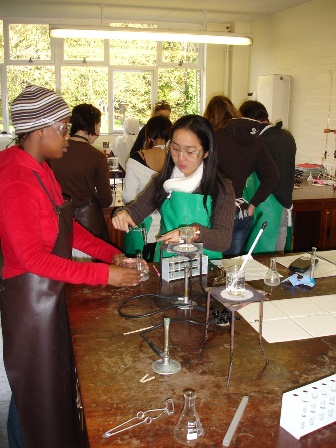Common chemical reactions

 Background information
Background information
 I usually start teaching the course with the first part of Topic 2.1 The nuclear atom. Once students know what an atom is I start Topic 1 Stoichiometric relationships. If your students have come up through the lower classes in your school they will probably know some basic chemical reactions. Mine come from all over the world with very different backgrounds and with varying knowledge and ability in English. To make sense of quantitative chemistry they need practical knowledge of some basic chemical reactions such as acids reacting with metals, metal oxides and carbonates and precipitation reactions etc. This practical is to give them that knowledge whilst familiarizing themselves with the laboratory, common apparatus and basic chemicals. Of course they all know already what a test-tube is and a beaker etc. but they may not know what they are called in English. I get the laboratory technician to put out pieces of apparatus with their names written in English on them. I also pair up the students so that a non-native speaker works with a native speaker. I'm sure there is no scientific logic behind the observation but as a rule of thumb the non-native speaker knows more chemistry and the native speaker knows the language so they are actually able to help each other to a remarkable extent!
I usually start teaching the course with the first part of Topic 2.1 The nuclear atom. Once students know what an atom is I start Topic 1 Stoichiometric relationships. If your students have come up through the lower classes in your school they will probably know some basic chemical reactions. Mine come from all over the world with very different backgrounds and with varying knowledge and ability in English. To make sense of quantitative chemistry they need practical knowledge of some basic chemical reactions such as acids reacting with metals, metal oxides and carbonates and precipitation reactions etc. This practical is to give them that knowledge whilst familiarizing themselves with the laboratory, common apparatus and basic chemicals. Of course they all know already what a test-tube is and a beaker etc. but they may not know what they are called in English. I get the laboratory technician to put out pieces of apparatus with their names written in English on them. I also pair up the students so that a non-native speaker works with a native speaker. I'm sure there is no scientific logic behind the observation but as a rule of thumb the non-native speaker knows more chemistry and the native speaker knows the language so they are actually able to help each other to a remarkable extent!
Teachers notes
These are very basic test-tube reactions so no particular extra information is needed. You may need to help them after they have heated copper(II) carbonate. It is best to then only take a very small amount of the black product (CuO) with the hydrochloric acid or they will not see a clear green solution when they warm it. They are asked to identify gases that are evolved. It would be useful to remind them how to test for hydrogen, oxygen and carbon dioxide. After they have done the reactions I ask them to try to explain their observations by writing the relevant equations. I then go over everything with them afterwards to make sure they do have the correct equations which we can then use as examples to work out molar quantities, limiting reactants etc. for Topic 1.

 Student worksheet
Student worksheet
SOME COMMON CHEMICAL REACTIONS
The aim of this practical is to observe and explain some important chemical reactions and to help non-native English speakers learn the English words for certain chemical terms. It will also provide you with some basic reactions and equations that can be used to solve problems in Topic 1 - Stoichiometric relationships.
ENVIRONMENTAL CARE: Use very small quantities of chemicals in small test-tubes to minimise both cost and damage to the environment. Apart from the first two experiments all the rest involve 'heavy metal' ions i.e. Cu2+(aq), Ag+(aq) and Ba2+(aq). The residues remaining from these experiments must be poured into the waste container in the fume cupboard marked 'Heavy Metal Waste'. Do not pour heavy metal ions down the sink.
SAFETY: When heating substances and whenever concentrated acids are being used you must wear safety glasses and a lab coat.
PROCEDURE:
Carry out the following reactions. Observe carefully and test for any gases given off. Record all your observations. Try to explain all your observations by writing balanced chemical equations for all the reactions taking place.
a. Add dilute hydrochloric acid to a small piece of magnesium.
b. Carefully add a few drops of concentrated sulfuric acid to solid sodium chloride.
c. Add dilute hydrochloric acid to solid copper(II) carbonate.
d. In a dry test-tube heat a little copper(II) carbonate. Using a teat pipette test for carbon dioxide with calcium hydroxide solution.
e. To the residue obtained from reaction (d) add a little dilute hydrochloric acid and warm.
f. Add silver nitrate solution to a solution of sodium chloride. Leave the product in sunlight for a few minutes.
g. Add barium chloride solution to a solution of sodium sulfate.
ENGLISH WORDS:
After you have completed the experiments you should make sure you are familiar with the following chemical terms.
Beaker, test-tube, measuring cylinder, analytical balance, pipette, burette
Solute, solvent, solution.
Dilute, concentrated.
Mass, volume.
Acidic, basic, neutral, amphoteric.
Soluble, insoluble, precipitate.
The names and chemical symbols for the first 32 elements in the Periodic Table.
This worksheet can also be downloaded from:

 IB Docs (2) Team
IB Docs (2) Team